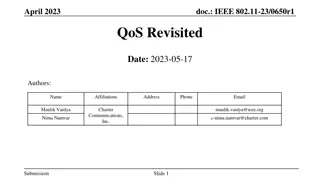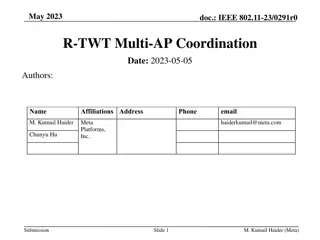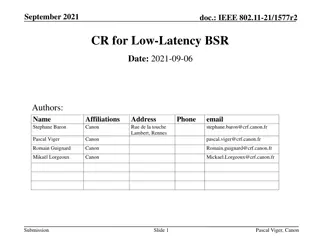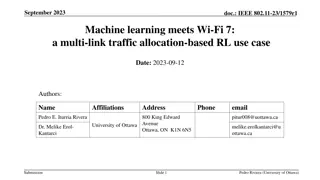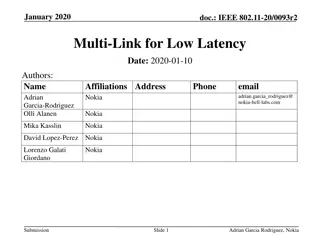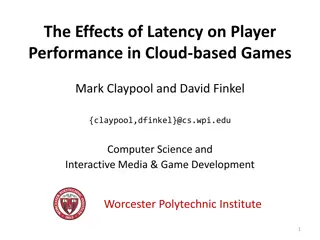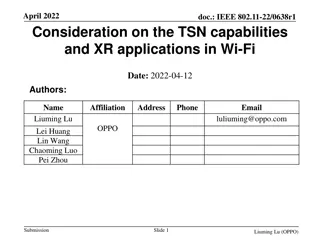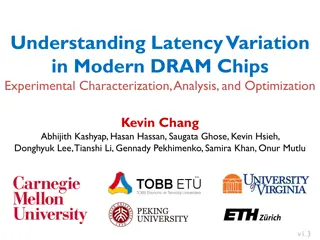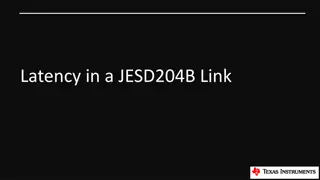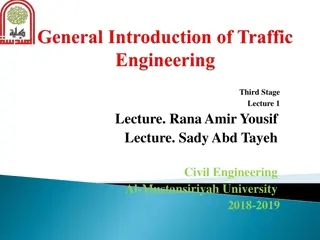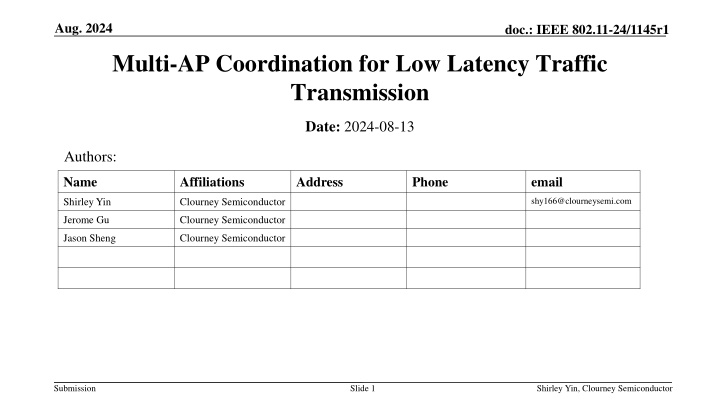
Multi-AP Coordination for Low Latency Traffic Transmission in IEEE 802.11-24
Explore the implementation of Multi-AP coordination to enhance low-latency traffic transmission in IEEE 802.11-24 standards, focusing on strategies like Coordinated Spatial Reuse and Coordinated Beamforming for improved latency and reliability. Learn how supporting low-latency traffic in a multi-AP environment can optimize performance and prioritization, ensuring timely and efficient data transmission.
Download Presentation

Please find below an Image/Link to download the presentation.
The content on the website is provided AS IS for your information and personal use only. It may not be sold, licensed, or shared on other websites without obtaining consent from the author. If you encounter any issues during the download, it is possible that the publisher has removed the file from their server.
You are allowed to download the files provided on this website for personal or commercial use, subject to the condition that they are used lawfully. All files are the property of their respective owners.
The content on the website is provided AS IS for your information and personal use only. It may not be sold, licensed, or shared on other websites without obtaining consent from the author.
E N D
Presentation Transcript
Aug. 2024 doc.: IEEE 802.11-24/1145r1 Multi-AP Coordination for Low Latency Traffic Transmission Date: 2024-08-13 Authors: Name Affiliations Address Phone email shy166@clourneysemi.com Shirley Yin Clourney Semiconductor Jerome Gu Clourney Semiconductor Jason Sheng Clourney Semiconductor Submission Slide 1 Shirley Yin, Clourney Semiconductor
Aug. 2024 doc.: IEEE 802.11-24/1145r1 Introduction Enabling at least one mode of operation capable of improving the tail of the latency distribution and jitter compared to EHT MAC/PHY operation, with mobility between BSSs is one of the objectives of 802.11bn[1]. A Motion on Multi-AP operation was approved [2] Move to add the following text to the TGbn SFD: Define a multi-AP Coordinated Spatial Reuse at TxOP-level with power control Define multi-AP Coordinated Beamforming Other multi-AP coordination modes are TBD Currently, most of the contributions for low-latency traffic focus within a single BSS[3-7]. Multi-AP preemption for LL traffic has been proposed in [8]. The introduction of multi-AP coordination to LL can reduce inference and prioritize LL transmission, thus guarantee the timely and reliable transmission of low-latency traffic. In this contribution, we would like to discuss the support of low latency traffic transmission in Multi-AP coordination. Submission Slide 2 Shirley Yin, Clourney Semiconductor
Aug. 2024 doc.: IEEE 802.11-24/1145r1 How The Multi-AP Coordination Works with LL traffic? LL latency traffic? Preemption? Supporting LL traffic does not necessarily mean supporting preemption only. Preemption ? Complexity Support LL traffic in multi-AP coordination with low complexity The LL traffic can enjoy the gain from Multi-AP coordination. Regarding four kinds of Multi-AP coordination C-SR: Allow spatial reuse decisions which are low latency traffic oriented. reducing latency & enhancing reliability. C-Beamforming: Whether should the non-STA be nulled, or be covered by beamforming? prioritizing LL traffic tranmissions. C-OFDMA: Sharing AP prioritizes TXOP allocation to shared AP with low latency traffic. reducing latency. Joint transmission: Much protocol impact and quite complicate. It can be for further study. Submission Slide 3 Shirley Yin, Clourney Semiconductor
Aug. 2024 doc.: IEEE 802.11-24/1145r1 Support LL Traffic in C-SR There are many ways for C-SR desgin. For example, ICF/ICR frame could be adopted for C-SR. As one simple option, introduce one bit for LL traffic notification in ICF/ICR. Decide the C-SR policy according to LL traffic indication When there is no LL traffic indicated in each related AP, the common co-ordination is applied, e.g., one AP decreases its transmission power to an acceptable level. When there is LL traffic indicated in one of the related APs, the AP with LL traffic gets sufficient power(also a proper MCS) in order to transmit LL traffic in time and reliably. When both related APs are with LL traffic, decide the C-SR policy according to the priority of LL traffic. AP2 (LL) AP1 AP1 AP2 (LL) STA2 STA2 STA1 STA1 AP2 performs power adjustment AP1 performs power adjustment Submission Slide 4 Shirley Yin, Clourney Semiconductor
Aug. 2024 doc.: IEEE 802.11-24/1145r1 Support LL Traffic in C-BF C-BF: An AP performs beamnulling to protect a neighbor AP transmission, while completing its beamformed transmission. Nulling protects neighbor AP s STA, also brings shrunk coverage. Decide which AP performs C-BF. When there are multiple STAs, Decide which STA(s) to be covered by beamforming. Decide which STA(s) to be nulled (for protection or interference reduction). Submission Slide 5 Shirley Yin, Clourney Semiconductor
Aug. 2024 doc.: IEEE 802.11-24/1145r1 Support LL Traffic in C-OFDMA MU-RTS/CTS frame exchange for LL traffic notification The MU-RTS/CTS frame exchange can be applied to multi-AP coordination [9]. Similarly, one bit can be introduced for LL traffic notification. Sharing AP transmitting an MU-RTS frame to poll LL notification from Shared AP. CTS frames could be simultaneously transmitted by Shared APs, to indicate whether there is LL traffic in queue and LL traffic related information could be transmitted either. AP1 s TXOP ...... ...... LL poll MU-RTS Trigger AP1 (Sharing AP) AP2 uses the TXOP later CTS AP2 (Shared AP) AP3 uses TXOP for LL Transmission at first. BA CTS AP3 (Shared AP) LL Notification LL arrives Submission Slide 6 Shirley Yin, Clourney Semiconductor
Aug. 2024 doc.: IEEE 802.11-24/1145r1 Discussions After LL notification: Detailed design TXOP sharing for the AP with LL traffic should be prioritized. The C-SR policy need to be decided. For example, biased to the AP with LL traffic. The C-BF policy should be decided, whether to cover a non-AP STA or null a non-AP STA. How to obtain more benefits from Multi-AP coordination? Interference reduction. Prioritize LL traffic transmission. Complexity Support LL in Multi-AP Coordination has a manageable complexity. Make sure to complete it in 11bn. More features enabling efficient LL traffic transmission Pre-emption in Multi-AP coordination. The joint transmission scenario. Slide 7 Submission Shirley Yin, Clourney Semiconductor
Aug. 2024 doc.: IEEE 802.11-24/1145r1 Summary Multi-AP coordination benefits the timely delivery of low latency traffic. Low latency traffic indication is with low complexity. It is necessary to indicate the presence of low latency traffic in multi-AP coordination. Submission Slide 8 Shirley Yin, Clourney Semiconductor
Aug. 2024 doc.: IEEE 802.11-24/1145r1 References [1] 23/0480r3, UHR Proposed PAR [2] 24/0171r12,TGbn Motions List [3] 24/0390r0, A Uniform Procedure for Preemption [4] 24/0389r0, Preemption for Low Latency [5] 24/0168r0, TXOP preemption in 11bn [6] 24/0625r0, Thoughts on Low Latency traffic transmission [7] 24/0811r0, Overlapped indication for aperiodic low latency traffic [8] 24/0636r0, Multi-AP Preemption for Low-Latency Traffic [9] 24/0941r0 TXOP Sharing Group - Shared AP Selection Submission Slide 9 Shirley Yin, Clourney Semiconductor

